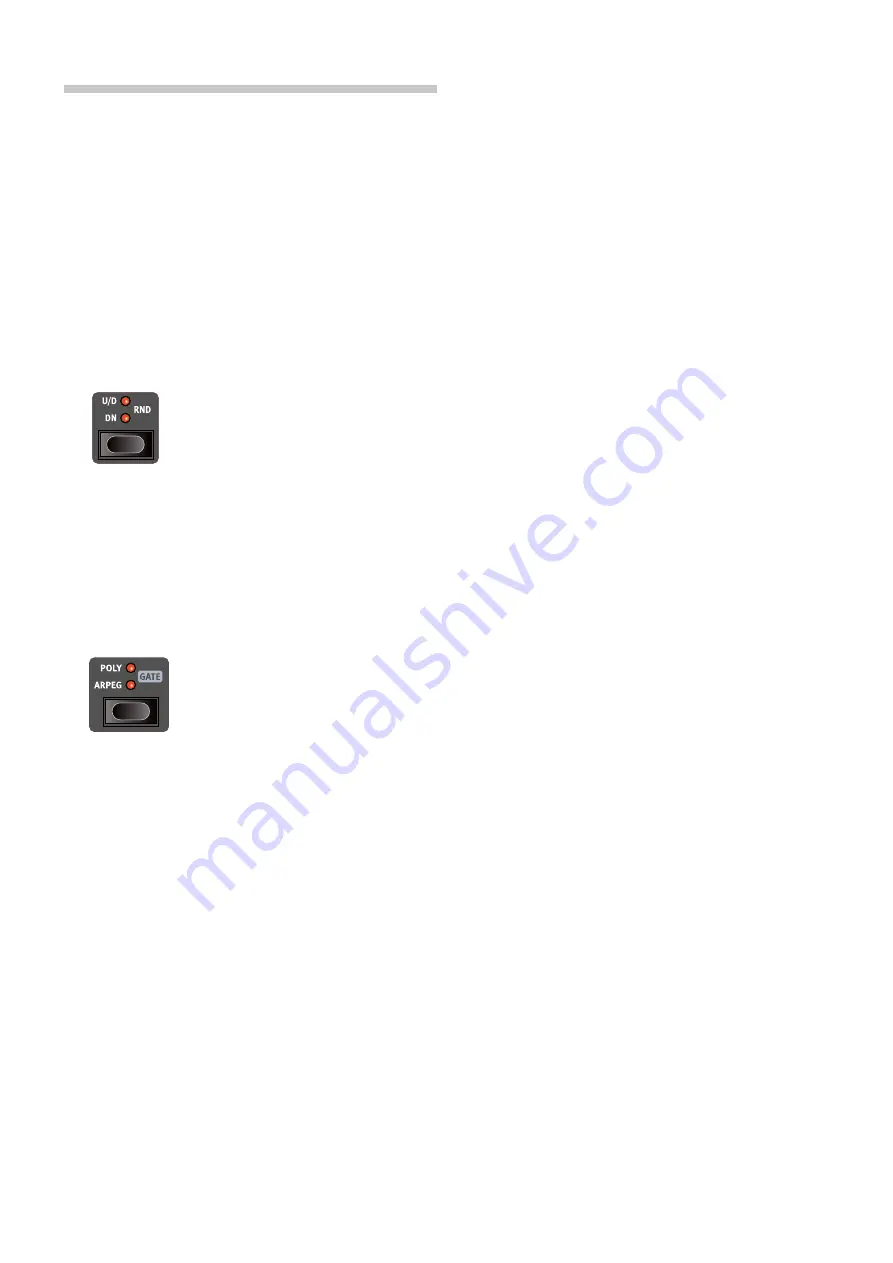
12 | Nord Wave 2 User MaNUal os v1.0x
THe arPeGGIaTor/GaTe
as a final exercise, let’s create a sound using the arpeggiator.
1
Make sure that only one layer is active and perform a
LAYER INIT
(shift+live Mode). set the amp env
ATTACK
time to 0,
DECAY
to
around 3 and
SUSTAIN
to 0, select a sawtooth waveform from the
ANALOG
oscillator types and open up the filter a little bit. This will
produce a percussive sound.
2
Press
RUN
for the arpeggiator/Gate section, play a chord on the
keyboard and turn the
TEMPO
knob. This will play the notes that are
held down, one after the other in a repeating fashion.
3
Press the direction
selector
button to select a different direction.
When no direction led is lit, the direction is Up, from the lowest
key and up to the highest and then it starts over again. The other
directions are
DN
(down),
UP/DN
(up and down) and
RD
(random).
4
Turn the range knob to adjust the range of the arpeggio. When
range is set to 2, the arpeggiator will repeat the held notes in the
octave above the original - and so forth up to the maximum range
of 4 octaves.
Values between whole octaves are possible as well.
5
Press the mode
selector
button and set it to
POLY
. set the
RANGE
to 0. Note that the arpeggiator now simply repeats any chord that
you hold. Try a larger range - the arpeggiator now plays inversion of
the held chord, according to the direction that is selected.
6
Finally, select the
GATE
mode. Note that notes now are not repeat-
ed – instead the volume level of the sound is rhytmically gated
according to the selected rate. adjust the amp env
SUSTAIN
parameter to ensure that your sound does not die out.
7
adjust the
ENV
(envelope) knob (same as the range knob) and
notice how the Gate becomes softer at 0 setting and very hard at
the maximum env amount.
MasTer CloCK
set up an arpeggio according to the previous section, and let’s try the
Master Clock feature to synchronize the arpeggio and bring in a syn-
chronized effect as well.
1
Hold
SHIFT
and turn the arpeggiator
TEMPO
knob to lock the
arpeggio to the Master Clock, the
MST CLK
led lights up.
2
Press down on the Mst Clk
TAP/SET
button in the Program area
to dial in a tempo with the
VALUE
dial. The display will indicate the
BPM. set this to 130 BPM for this exercise. release the button to
exit..
Tap four times on the Mst Clk button to set the tempo on the fly.
3
Turn the arpeggio
RATE
knob to select the meter subdivision (or
note values) that the arpeggio should play. The setting is shown
in the Program area display as the knob is being turned. Notice
how 1/4 is half the “speed “ of 1/8. a “T” after a numerical value
indicates triplets. set the subdivision to 1/8.
4
Turn on the
DELAY
effect, hold
SHIFT
and turn the delay
TEMPO
knob to activate Master Clock for the delay. The
MST CLK
led
lights up.
5
Turn the delay
TEMPO
knob and again refer to the Program area
display to monitor the setting.
6
Try 1/16, which will be half the note value or twice the “speed” of
the arpeggio. Turn the
DRY/WET
knob up to around 12 o’clock to
hear the delay taps together with the arpeggiated notes.
The arpeggio/Gate, the lFo, the delay and the effect rate can be syn-
chronized to the Master Clock in this fashion.
What’s more, the Master Clock operates on all layers simultaneously
so you can control arpeggios, lFos and effects on all active layers in a
program.
some of the synchronizable units have division settings that are larger
than 1/1 that allows for sweeps that are longer that one bar. and you
can of course synchronize some functions, while leaving others free-run-
ning if you like.
Содержание Nord Wave 2
Страница 40: ......



























